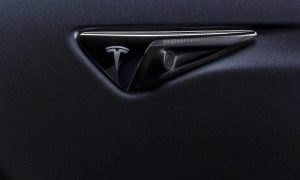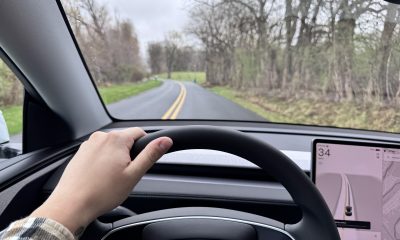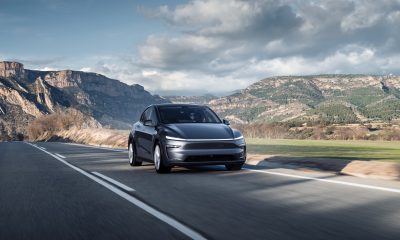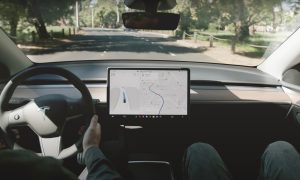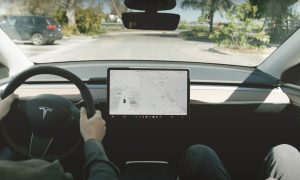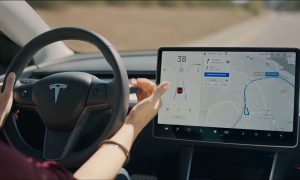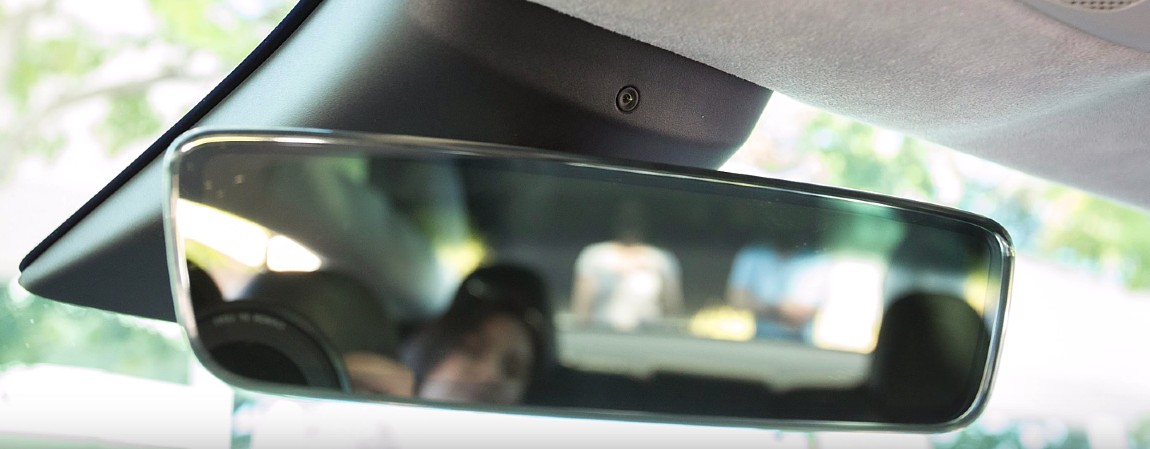

News
IIHS announces new ratings set for the safeguards of semi-autonomous vehicles
The Insurance Institute for Highway Safety (IIHS) has announced that it is developing a new ratings program that evaluates the safeguards that vehicles with partial automation employ to help drivers stay attentive.
The IIHS will use four levels for rating the safeguards: good, acceptable, marginal, or poor. Vehicles with “good” safeguard system ratings will need to ensure that the driver’s eyes are directed at the road and their hands are either on the wheel or ready to grab it at any point. Vehicles with escalating alert systems and appropriate emergency procedures when a driver does not meet those conditions will also be required, the IIHS said.
Expectations for the IIHS are that the first set of ratings will be released in 2022. The precise timing is currently not solidified as supply chain bottlenecks have affected the IIHS’ ability to obtain test vehicles from manufacturers.
IIHS President David Harkey believes a rating system for these “driver monitoring” systems could determine their effectiveness and whether safeguards actually hold drivers accountable. “Partial automation systems may make long drives seem like less of a burden, but there is no evidence that they make driving safer,” Harkey said. ” In fact, the opposite may be the case if systems lack adequate safeguards.”
Self-driving cars are not yet available to consumers, the IIHS reassures in its press release. While some advertising operations or product names could be somewhat misleading, the IIHS admits that some vehicles have partial automation. However, the human driver is still required to handle many routine driving tasks that many of the systems simply cannot perform. The driver always needs to be attentive and monitor the vehicle’s behavior, especially in case of an emergency where the driver needs to take over control of the car. The numerous semi-autonomous or partially automated programs on the market, like Tesla Autopilot, Volvo Pilot Assist, and GM’s Super Cruise, to name a few, all have safeguards in place to help ensure drivers are focused and ready. However, the IIHS says that “none of them meet all the pending IIHS criteria.”
The previously named partially automated driving systems all use cameras, radar, or other sensors to “see” the road. Systems currently offered on the market combine Adaptive Cruise Control (ACC) and lane centering with other driver assistance features. Automated lane changing is becoming common as well, and is a great example of one of these additional features.
Regardless of how many features a semi-autonomous driving program has, all of them still require the driver to remain attentive and vigilant during operation. This does not mean that all drivers maintain attention, as some may use cheat devices or other loopholes to operate a vehicle with semi-autonomous features in a fully autonomous way. Additionally, the IIHS mentions in its press release that some manufacturers “have oversold the capabilities of their systems, prompting drivers to treat the systems as if they can drive the car on their own.”
RELATED:
Level 2 systems like Tesla Autopilot can improve drivers’ attentiveness: IIHS study
The main issue is the fact that many operators deliberately misuse the systems. IIHS Research Scientist Alexandra Mueller is spearheading the new ratings program, and she says that abuse of the systems is one of many problems with semi-autonomous vehicle features.
“The way many of these systems operate gives people the impression that they’re capable of doing more than they really are,” Mueller said regarding the features. “But even when drivers understand the limitations of partial automation, their minds can still wander. As humans, it’s harder for us to remain vigilant when we’re watching and waiting for a problem to occur than it is when we’re doing all the driving ourselves.”
There is no way to monitor a driver’s thoughts or their level of focus on driving. However, there are ways to monitor gaze, head and hand position, posture, and other indicators that, when correctly displayed, could be consistent with someone who is actively engaged in driving.
The IIHS’ new ratings program aims to encourage the introduction of safeguards that can help reduce intentional and unintentional misuse. They would not address the functional aspects of some systems and whether they are activating properly, which could also contribute to crashes. It will only judge the systems that monitor human behaviors while driving.
“To earn a good rating, systems should use multiple types of alerts to quickly remind the driver to look at the road and return their hands to the wheel when they’ve looked elsewhere or left the steering unattended for too long. Evidence shows that the more types of alerts a driver receives, the more likely they will notice them and respond. These alerts must begin and escalate quickly. Alerts might include chimes, vibrations, pulsing the brakes, or tugging on the driver’s seat belt. The important thing is that the alerts are delivered through more channels and with greater urgency as time passes,” the IIHS says. Systems that work effectively would perform necessary maneuvers, like bringing the vehicle to a crawl or a stop if drivers that fail to respond to the numerous alerts. If an escalation of this nature occurs, the driver should be locked out of the system or the remainder of the drive, or until the vehicle is turned off and back on.
The rating criteria may also include certain requirements for automated lane changes, ACC, and lane centering. Automated lane changes should be initiated, or at least confirmed, by the driver before they are performed. If a vehicle comes to a complete stop when an ACC system is activated, the system “should not automatically resume if the driver is not looking at the road or the vehicle has been stopped for too long.” Lane centering features should also encourage the driver to share in steering, rather than switching off automatically when the driver adjusts the wheel. This could discourage some drivers from participating in driving, the IIHS said. Systems should also not be used if a seatbelt is unfastened, or when AEB or lane departure prevention is disabled.
“Nobody knows when we’ll have true self-driving cars, if ever. As automakers add partial automation to more and more vehicles, it’s imperative that they include effective safeguards that help drivers keep their heads in the game,” Harkey said.
I’d love to hear from you! If you have any comments, concerns, or questions, please email me at joey@teslarati.com. You can also reach me on Twitter @KlenderJoey, or if you have news tips, you can email us at tips@teslarati.com.
News
These Tesla, X, and xAI engineers were just poached by OpenAI
The news is the latest in an ongoing feud between Elon Musk and the Sam Altman-run firm OpenAI.

OpenAI, the xAI competitor for which Elon Musk previously served as a boardmember and helped to co-found, has reportedly poached high-level engineers from Tesla, along with others from xAI, X, and still others.
On Tuesday, Wired reported that OpenAI hired four high-level engineers from Tesla, xAI, and X, as seen in an internal Slack message sent by co-founder Greg Brockman. The engineers include Tesla Vice President of Software Engineering David Lau, X and xAI’s head of infrastructure engineering Uday Ruddarraju, and fellow xAI infrastructure engineer Mike Dalton. The hiring spree also included Angela Fan, an AI researcher from Meta.
“We’re excited to welcome these new members to our scaling team,” said Hannah Wong, an OpenAI spokesperson. “Our approach is to continue building and bringing together world-class infrastructure, research, and product teams to accelerate our mission and deliver the benefits of AI to hundreds of millions of people.”
Lau has been in his position as Tesla’s VP of Software Engineering since 2017, after previously working for the company’s firmware, platforms, and system integration divisions.
“It has become incredibly clear to me that accelerating progress towards safe, well-aligned artificial general intelligence is the most rewarding mission I could imagine for the next chapter of my career,” Lau said in a statement to Wired.
🚨Optimistic projections point to xAI possibly attaining profitability by 2027, according to Bloomberg's sources.
If accurate, this would be quite a feat for xAI. OpenAI, its biggest rival, is still looking at 2029 as the year it could become cash flow positive.💰 https://t.co/pE5Z9daez8
— TESLARATI (@Teslarati) June 18, 2025
READ MORE ON OPENAI: Elon Musk’s OpenAI lawsuit clears hurdle as trial looms
At xAI, Ruddarraju and Dalton both played a large role in developing the Colossus supercomputer, which is comprised of over 200,000 GPUs. One of the major ongoing projects at OpenAI is the company’s Stargate program,
“Infrastructure is where research meets reality, and OpenAI has already demonstrated this successfully,” Ruddarraju told Wired in another statement. “Stargate, in particular, is an infrastructure moonshot that perfectly matches the ambitious, systems-level challenges I love taking on.”
Elon Musk is currently in the process of suing OpenAI for shifting toward a for-profit model, as well as for accepting an investment of billions of dollars from Microsoft. OpenAI retaliated with a counterlawsuit, in which it alleges that Musk is interfering with the company’s business and engaging in unfair competition practices.
Elon Musk confirms Grok 4 launch on July 9 with livestream event
News
SpaceX share sale expected to back $400 billion valuation
The new SpaceX valuation would represent yet another record-high as far as privately-held companies in the U.S. go.

A new report this week suggests that Elon Musk-led rocket company SpaceX is considering an insider share sale that would value the company at $400 billion.
SpaceX is set to launch a primary fundraising round and sell a small number of new shares to investors, according to the report from Bloomberg, which cited people familiar with the matter who asked to remain anonymous due to the information not yet being public. Additionally, the company would sell shares from employees and early investors in a follow-up round, while the primary round would determine the price for the secondary round.
The valuation would represent the largest in history from a privately-owned company in the U.S., surpassing SpaceX’s previous record of $350 billion after a share buyback in December. Rivaling company valuations include ByteDance, the parent company of TikTok, as well as OpenAI.
Bloomberg went on to say that a SpaceX representative didn’t respond to a request for comment at the time of publishing. The publication also notes that the details of such a deal could still change, especially depending on interest from the insider sellers and share buyers.
Axiom’s Ax-4 astronauts arriving to the ISS! https://t.co/WQtTODaYfj
— TESLARATI (@Teslarati) June 26, 2025
READ MORE ON SPACEX: SpaceX to decommission Dragon spacecraft in response to Pres. Trump war of words with Elon Musk
SpaceX’s valuation comes from a few different key factors, especially including the continued expansion of the company’s Starlink satellite internet company. According to the report, Starlink accounts for over half of the company’s yearly revenue. Meanwhile, the company produced its 10 millionth Starlink kit last month.
The company also continues to develop its Starship reusable rocket program, despite the company experiencing an explosion of the rocket on the test stand in Texas last month.
The company has also launched payloads for a number of companies and government contracts. In recent weeks, SpaceX launched Axiom’s Ax-4 mission, sending four astronauts to the International Space Station (ISS) for a 14-day stay to work on around 60 scientific experiments. The mission was launched using the SpaceX Falcon 9 rocket and a new Crew Dragon capsule, while the research is expected to span a range of fields including biology, material and physical sciences, and demonstrations of specialized technology.
News
Tesla Giga Texas continues to pile up with Cybercab castings
Tesla sure is gathering a lot of Cybercab components around the Giga Texas complex.

Tesla may be extremely tight-lipped about the new affordable models that it was expected to start producing in the first half of the year, but the company sure is gathering a lot of Cybercab castings around the Giga Texas complex. This is, at least, as per recent images taken of the facility.
Cybercab castings galore
As per longtime drone operator Joe Tegtmeyer, who has been chronicling the developments around the Giga Texas complex for several years now, the electric vehicle maker seems to be gathering hundreds of Cybercab castings around the factory.
Based on observations from industry watchers, the drone operator appears to have captured images of about 180 front and 180 rear Cybercab castings in his recent photos.
Considering the number of castings that were spotted around Giga Texas, it would appear that Tesla may indeed be preparing for the vehicle’s start of trial production sometime later this year. Interestingly enough, large numbers of Cybercab castings have been spotted around the Giga Texas complex in the past few months.
Cybercab production
The Cybercab is expected to be Tesla’s first vehicle that will adopt the company’s “unboxed” process. As per Tesla’s previous update letters, volume production of the Cybercab should start in 2026. So far, prototypes of the Cybercab have been spotted testing around Giga Texas, and expectations are high that the vehicle’s initial trial production should start this year.
With the start of Tesla’s dedicated Robotaxi service around Austin, it might only be a matter of time before the Cybercab starts being tested on public roads as well. When this happens, it would be very difficult to deny the fact that Tesla really does have a safe, working autonomous driving system, and it has the perfect vehicle for it, too.
-

 Elon Musk1 week ago
Elon Musk1 week agoTesla investors will be shocked by Jim Cramer’s latest assessment
-

 News2 weeks ago
News2 weeks agoTesla Robotaxi’s biggest challenge seems to be this one thing
-

 Elon Musk1 day ago
Elon Musk1 day agoElon Musk confirms Grok 4 launch on July 9 with livestream event
-

 News2 weeks ago
News2 weeks agoWatch the first true Tesla Robotaxi intervention by safety monitor
-

 News5 days ago
News5 days agoTesla Model 3 ranks as the safest new car in Europe for 2025, per Euro NCAP tests
-

 Elon Musk2 weeks ago
Elon Musk2 weeks agoA Tesla just delivered itself to a customer autonomously, Elon Musk confirms
-

 Elon Musk2 weeks ago
Elon Musk2 weeks agoxAI welcomes Memphis pollution results, environmental groups push back
-

 Elon Musk2 weeks ago
Elon Musk2 weeks agoElon Musk confirms Tesla Optimus V3 already uses Grok voice AI


